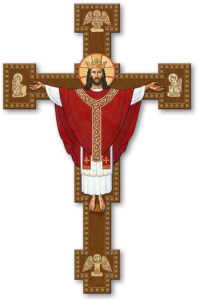Mount Calvary Church
A Roman Catholic Parish
The Personal Ordinariate of S. Peter
Eutaw Street and Madison Avenue
Baltimore, Maryland
November 24, 2019
The Feast of Christ the King
Rev. Albert Scharbach, Pastor
Dr. Allen Buskirk, Choirmaster
Midori Ataka, Organist
8:00 A.M. Said Mass
10:00 A.M. Sung Mass
Brunch to follow in the undercroft
_______________
Prelude
We Gather Together, arranged by Franklin Ritter
Postlude
Sing Praise to God Who Reigns Above, arranged by Hal H Hopson
________________
Common
Missa S. Maria Magdalena, Willan
________________
Anthems
Lift up your heads, O ye gates, George Fredrick Handel (1685-1759)
Born in Halle, Germany in 1685, Handel mastered counterpoint and harmony in the Baroque North German style. After a five year sojourn in Rome, he moved to London permanently in 1710, where he wrote and produced Italian opera. His music was wildly successful in England, but in the 1730s the cost of production of operas and changes in musical taste led him to focus his efforts on oratorios (which were cheaper because they are not staged). His oratorio Messiah was composed in three to four weeks in the fall of 1741 and was premiered at Easter in 1742 in Dublin. Handel gave his portion of the proceeds to a hospital and debtor’s prison in Dublin.
This chorus appears in Part II of the oratorio which describes the passion of Christ and his resurrection. These verses from Psalm 24 (using the text of the Book of Common Prayer) refer to Christ’s ascension into heaven. Handel divides the choir into a high group that announces his coming and a lower group of voices that questions “who is this king of glory?” This psalms announces that Christ is the King of Glory and the Lord of Hosts (meaning armies), a fitting depiction for today’s feast.
________
Worthy is the Lamb, George Fredrick Handel (1685-1759)
The final chorus in Handel’s Messiah at the end of Part III is “Worthy is the Lamb,” taken from the same text (Revelation 5:12-13) that is the basis of today’s Introit. The piece opens with a full-throated acclamation “Worthy is the Lamb that was slain” to receive our praise. In the second section, the men state the fugue theme “Blessing and honour, glory and power be unto him” which is developed with elaborate and increasingly complex counterpoint. At the end of this fugue, another begins on a new subject in the bass voices on “Amen.” This pair of fugues are the most compelling in all of Handel’s choral writing. Handel’s first biographer wrote in 1760 that this conclusion revealed the composer “rising still higher” than in “that vast effort of genius, the Hallelujah chorus.”
_________________
Hymns
#352 Crown Him with Many Crowns (DIADEMATA) is by the Anglican Matthew Bridges (1800-1894), who wrote six verses of this hymn, which is based on Rev: 1: 12: “and on His head were many crowns.” But Bridges converted to Catholicism in 1848 under the influence of John Henry Newman,, and Godfrey Thring (1823-1903) thought the hymn was too Catholic, and wrote six more verses, so hymnals, depending on their leanings, use different selections of verses. In the 1940 Hymnal the first and last verses are by Bridges, the middle three by Thring. The tune DIADEMATA (Crowns) is by Sir George Job Elvey (1816-1893), private organist to Queen Victoria,and is in the simple Handelian style.
For a complete discussion of this hymn see Nov. 20, 2016 blog.
#345 The King of love my shepherd is (ST COLUMBA) was written by Sir Henry Williams Baker (1821–1877). It is notable for its skillful meter, and its well-managed rhyme scheme of single and double rhymes, which control and shape the emotion very beautifully. Baker gave an Anglican slant to Psalm 23, interpreting it as a psalm of love and care, but stressing these qualities as evidenced in the Eucharist. The spread table of verse 5 becomes the altar on which the elements are displayed, and the delight comes as the believer takes the ‘pure chalice’; the unction, or anointing (from 1 John 2: 27), while bestowing grace in a spiritual sense, also has suggestions of a rite. This verse spreads its meaning through the whole hymn, allowing the words of Psalm 23 to acquire an extra significance: so that the last verse suggests that the length of days of a person’s life can be spent, figuratively, ‘within thy house for ever’, in the service and under the influence of the church, and then later in heaven. The singer can reflect back, and conclude that the first verses suggest the ransomed soul, sought out in love and rescued from sin (Baker’s version of ‘he restoreth my soul’). The beautiful use of the shepherd metaphor in verse 3, as the shepherd carries the lamb gently on his shoulder, is an illustration of the tenderness of Baker’s work: these lines were the last words spoken by Baker on his deathbed.
To Jesus Christ our sovereign King (ICH GLAUB’ AN GOTT) is by Msgr. Martin Hellriegel (1890-1981), a German-American Roman Catholic priest who immigrated to the Archdiocese of St. Louis, Missouri, from Heppenheim, Germany and became one of the pioneers of the Catholic Liturgical Movement. The hymn was written in 1941 as a direct response to the pretensions of the Third Reich and to remind people who actually reigns eternally. The tune was published in the Mainz Gesangbuch (1870).
